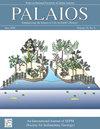作为盐度和古环境指标的遗迹化石柱状体的评价
IF 1.5
4区 地球科学
Q2 GEOLOGY
引用次数: 0
摘要
摘要:在平行至开阔的海洋沉积环境中,Teredolites和Teredolite Ichnoes是公认的海洋影响的代表。当Teredolites存在时,现有方法和工艺技术框架允许对定量和半定量数据进行独立分析,以解释物理化学条件。在现代环境和侏罗纪-始新世序列中收集的测量结果产生了一个空间和时间上稳健的数据集,该数据集包含来自17个示踪属的14137个钻孔。现存痕迹制作者的生活史策略反映在中生代钻孔中,这允许重建古盐度。推断出的趋势表明,现代近海环境中有四个交错带,可以确定为晚白垩世。这些区域显示了Teredolite的钻孔指标(长度[L]、宽度[W]、L:W比、尺寸多样性指数)、密度和相对组成的变化。1区代表上游河口至潮汐变化的河流序列,盐度为0.5–10 ppt(少卤盐至α-中卤盐)。2区代表从上游到中部的河口序列,盐度为10-19 ppt(β-中盐盐到下多盐)。3区代表中部至下部河口序列,盐度为15-30 ppt(β-中岩盐至真岩盐)。4区代表后滨至开阔海域序列,盐度为20-30 ppt(多盐至真盐)。与已确定的化石属相比,无聊的指标表明,在白垩纪晚期,西部内陆航道的高物种丰富度与补偿种间竞争的物理适应相吻合,即定居时繁殖方式和媒介偏好的差异。本文章由计算机程序翻译,如有差异,请以英文原文为准。
EVALUATING THE ICHNOFOSSIL TEREDOLITES AS AN INDICATOR OF SALINITY AND PALEOENVIRONMENT
Abstract: The ichnogenus Teredolites and the Teredolites Ichnofacies is an accepted proxy for marine influence in paralic to open marine depositional environments. Actualistic approaches and the process-ichnologic framework allow independent analysis of both quantitative and semiquantitative data to interpret the physicochemical conditions when Teredolites are present. Measurements collected in modern environments and Jurassic–Eocene successions produce a spatially and temporally robust dataset of 14,137 borings from 17 tracemaking genera. Life history strategies of extant tracemakers are reflected in Mesozoic borings, which allow reconstruction of paleosalinity. Trends extrapolated indicate four ecotones in modern paralic to nearshore settings, which can be identified into the Late Cretaceous. These zones display variation in boring metrics (length [L], width [W], L:W ratio, size diversity index), densities, and relative composition of Teredolites. Zone 1 represents upper estuary to tidally modified fluvial successions with salinities from 0.5–10 ppt (oligohaline to alpha-mesohaline). Zone 2 represents upper to central estuary successions with salinities from 10–19 ppt (beta-mesohaline to lower polyhaline). Zone 3 represents central to lower estuary successions with salinities from 15–30 ppt (beta-mesohaline to euhaline). Zone 4 represents backshore to open marine successions with salinities from 20–30+ ppt (polyhaline to euhaline). Boring metrics compared against identified fossil genera suggest high species richness in the Western Interior Seaway coincided with physical adaptations to compensate for interspecific competition––differences in reproduction style and media preferences at the time of settlement––in the Late Cretaceous.
求助全文
通过发布文献求助,成功后即可免费获取论文全文。
去求助
来源期刊

Palaios
地学-地质学
CiteScore
2.80
自引率
12.50%
发文量
40
审稿时长
6 months
期刊介绍:
PALAIOS is a monthly journal, founded in 1986, dedicated to emphasizing the impact of life on Earth''s history as recorded in the paleontological and sedimentological records. PALAIOS disseminates information to an international spectrum of geologists and biologists interested in a broad range of topics, including, but not limited to, biogeochemistry, ichnology, paleoclimatology, paleoecology, paleoceanography, sedimentology, stratigraphy, geomicrobiology, paleobiogeochemistry, and astrobiology.
PALAIOS publishes original papers that emphasize using paleontology to answer important geological and biological questions that further our understanding of Earth history. Accordingly, manuscripts whose subject matter and conclusions have broader geologic implications are much more likely to be selected for publication. Given that the purpose of PALAIOS is to generate enthusiasm for paleontology among a broad spectrum of readers, the editors request the following: titles that generate immediate interest; abstracts that emphasize important conclusions; illustrations of professional caliber used in place of words; and lively, yet scholarly, text.
 求助内容:
求助内容: 应助结果提醒方式:
应助结果提醒方式:


